Moira Butterfield's Blog, page 28
January 21, 2019
Helping young children create stories by Jane Clarke
Next week, it’s National Storytelling Week in the UK - and I’ll be out and about in local libraries and primary schools - sharing stories and helping children to create their own.
We will have a lot of fun. Of course, there are lots of ways to do this, but I like to set up a scenario appropriate to the children’s age, brainstorm it, and run with what ever they suggest, if necessary nudging it along by asking them questions and making suggestions that can be silly or surreal.
e.g. What does your teddy bear get up to when you’re not looking ?
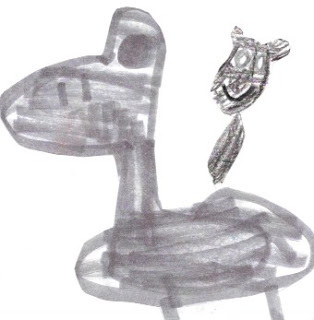 This teddy bear snuck out in the dark to ride a shadow duck.
This teddy bear snuck out in the dark to ride a shadow duck.
Think of your favourite animal. Now give it a problem…
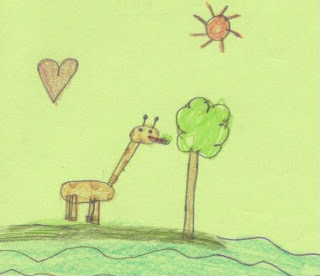 This giraffe got marooned on a desert island, but was rescued by pirates and fell in love with a piratical parrot
This giraffe got marooned on a desert island, but was rescued by pirates and fell in love with a piratical parrot
What would happen if you woke up and you/your mum/dad/brother/sister/teacher had turned into or been replaced by eg. a monster, a giant, a dragon?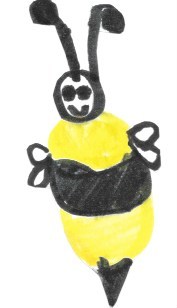 or a giant bee who made everyone collect pollen for her. The school filled with pollen, it made everyone sneeze (shouts of ATCHOOO) and the noise frightened the giant bee so she buzzed off.What might you see… if you took a rocket into space … a submarine under the sea ….go back in the past and discover a new dinosaur?
or a giant bee who made everyone collect pollen for her. The school filled with pollen, it made everyone sneeze (shouts of ATCHOOO) and the noise frightened the giant bee so she buzzed off.What might you see… if you took a rocket into space … a submarine under the sea ….go back in the past and discover a new dinosaur?
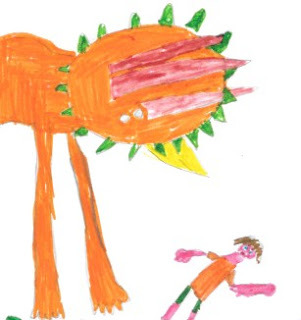 warning - not every story will have a happy ending!
warning - not every story will have a happy ending!
The stories that are created won’t be at all polished, they’re likely to lack internal logic, a proper beginning or end, and they will often owe a lot to whatever cartoons the children are currently watching on TV or books they are reading. But they will be full of fizz and it’s wonderful to see how excited the children get as they think up their story.
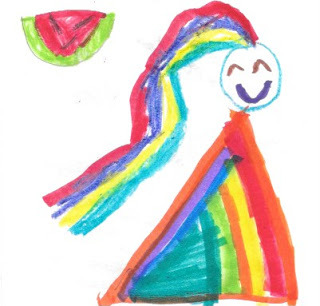
‘it makes me happy, like I’m eating watermelon and my head is filled with rainbows’ said the illustrator :-)
And that’s a great reminder of what can get lost in the rigours of creating a story for publication. So if you’re writing picture books take a storytelling break next week - eat some watermelon, fill you head with rainbows, dump your internal censor/editor and have fun!
Jane’s latest picture book, Leap Frog, illustrated by Britta Teckentrup, will be published in the UK on February 7, 2019
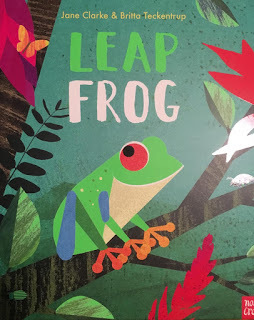
We will have a lot of fun. Of course, there are lots of ways to do this, but I like to set up a scenario appropriate to the children’s age, brainstorm it, and run with what ever they suggest, if necessary nudging it along by asking them questions and making suggestions that can be silly or surreal.
e.g. What does your teddy bear get up to when you’re not looking ?
 This teddy bear snuck out in the dark to ride a shadow duck.
This teddy bear snuck out in the dark to ride a shadow duck.Think of your favourite animal. Now give it a problem…
 This giraffe got marooned on a desert island, but was rescued by pirates and fell in love with a piratical parrot
This giraffe got marooned on a desert island, but was rescued by pirates and fell in love with a piratical parrotWhat would happen if you woke up and you/your mum/dad/brother/sister/teacher had turned into or been replaced by eg. a monster, a giant, a dragon?
 or a giant bee who made everyone collect pollen for her. The school filled with pollen, it made everyone sneeze (shouts of ATCHOOO) and the noise frightened the giant bee so she buzzed off.What might you see… if you took a rocket into space … a submarine under the sea ….go back in the past and discover a new dinosaur?
or a giant bee who made everyone collect pollen for her. The school filled with pollen, it made everyone sneeze (shouts of ATCHOOO) and the noise frightened the giant bee so she buzzed off.What might you see… if you took a rocket into space … a submarine under the sea ….go back in the past and discover a new dinosaur?
 warning - not every story will have a happy ending!
warning - not every story will have a happy ending! The stories that are created won’t be at all polished, they’re likely to lack internal logic, a proper beginning or end, and they will often owe a lot to whatever cartoons the children are currently watching on TV or books they are reading. But they will be full of fizz and it’s wonderful to see how excited the children get as they think up their story.

‘it makes me happy, like I’m eating watermelon and my head is filled with rainbows’ said the illustrator :-)
And that’s a great reminder of what can get lost in the rigours of creating a story for publication. So if you’re writing picture books take a storytelling break next week - eat some watermelon, fill you head with rainbows, dump your internal censor/editor and have fun!
Jane’s latest picture book, Leap Frog, illustrated by Britta Teckentrup, will be published in the UK on February 7, 2019

Published on January 21, 2019 01:00
January 13, 2019
Draw me a hamster with an elephant's body driving a Lamborghini
Garry Parsons describes how he approaches visiting schools to talk about his work as an illustrator, gives some tips on how to do it, and asks two teachers why they feel author and illustrator visits are beneficial to pupils.
One of the surprises of working as an illustrator in children’s publishing was being asked to take part in live events. My first picture book, Billy’s Bucketby Kes Gray, won three awards during the first year of its publication and, as the illustrator, I was expected to speak publicly. Being a fairly private person, this was very daunting at first and, looking back, I’m sure in those first few years my events were probably pretty awful. But experience is a great teacher and I have learnt a lot about speaking in public and adapted my repertoire to hopefully enthuse and inspire children to pick up a pencil or read a book.

This Friday I visited a school in South London, my first of the year, and, with the thought of a busy World Book Week close on the horizon, I was keen to start the season off with a real cracker.
Tip 1: Arrive in plenty of time.With my mild anxiety about being late dealt with by arriving at the school half an hour early, I was greeted enthusiastically by the teacher I had been organizing the event with, and led around the school to where my workshops would be taking place during the day, and to the hall for the assembly.
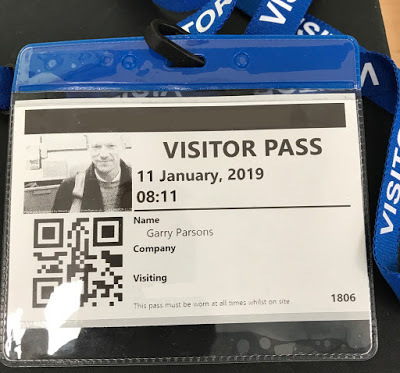
Tip 2: Set up your wares before the kids arrive.I like to be drawing as the children are filing into the hall. You can hear the muffled chatter of excitement and murmurs of “Who?” “What?” “How?” and “Wow!” Children are gripped by live drawing, so I like to make the most of the flip chart paper.
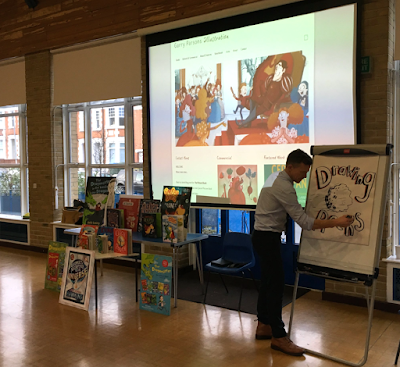
Tip 3: Get everyone’s attention straight away. I like to do this by asking a question immediately. “Does anyone here like to draw?” I ask, and usually around 80% of hands go up.
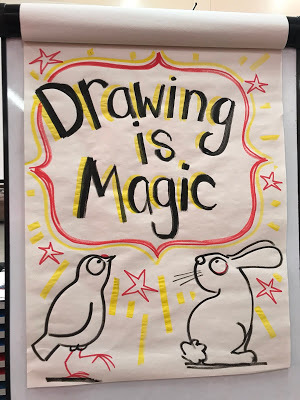
I go on to tell them that there are three things that an illustrator needs, we quickly work out between us what these might be, and I draw these on the flip chart with fast strokes of a fat marker. Children love to interact with moans and laughter when I inform them that my pencil is in love with someone but it’s not me!
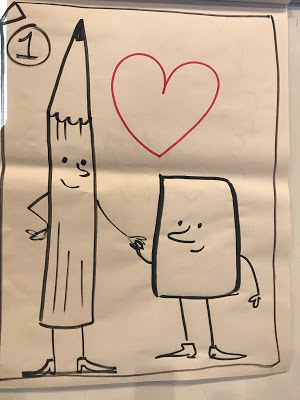
We go through the importance of PRACTICE by unravelling a long concertina sketchbook, and the abstract notion of using your IMAGINATION by drawing a brave volunteer’s portrait. But I get it ‘wrong’ under the influence of my vivid imagination, which seemingly has a mind of its own and might add an elephant’s trunk, crazy oversized hair or giant ears to the drawing. This brings on peels of laughter.
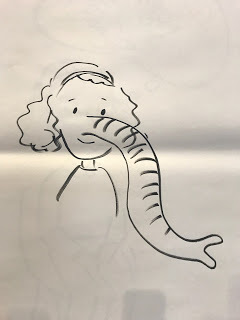
By this point I usually feel I have the room engaged, but the time has flown by and I need to wrap it up with a five minute Q&A or, if it’s a longer assembly, I might continue with ‘Challenge the Illustrator,’ where I tell the children I can draw anything and they give me three random elements to put together in two minutes, a gorilla on a unicycle in Wembley Stadium or . Either way, my intention is to have lit a fuse of enthusiasm that will carry me and the students into a series of workshops for the rest of the day.

In the workshops I explain the process of illustration, from text to final artwork, and how a picture book is made. I use examples of my work to show each of the stages and emphasise how important it is to keep the first stages fluid and not to be concerned about perfection and getting things right. That's where the romance of the pencil and the rubber comes in.
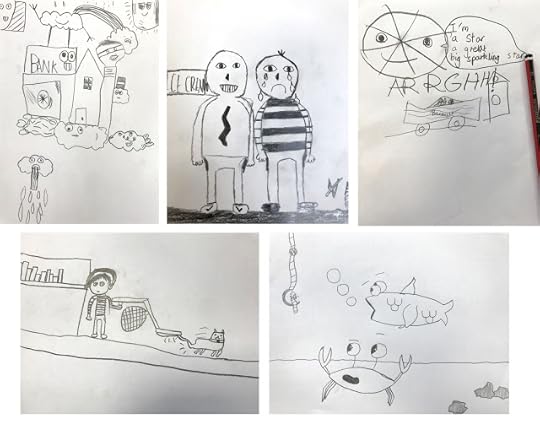
So how did the day in South London go? Well, it was a marvellous day with responsive children and enthusiastic and welcoming staff, it felt great and everyone seemed happy.
This is what they said...
We had a very exciting visit from illustrator Garry Parsons. He amazed the children in an assembly with his illustration skills and quick imagination! His inspirational assembly and workshops had children in awe with a lot of spontaneous clapping.

But how do I know that schools really do get something out of author and illustrator visits? Is it worth schools spending scarce resources this way?
I asked two experienced teachers from schools in Kent to get an inside point of view on why author and illustrator visits might be of benefit to them and their pupils and how they know a visit may have had an effect.
Mrs Bryant told me:A visitor to your school can give pupils a fresh engagement with a subject, whether that is reading, writing or drawing, or even something less obvious like bee keeping or gymnastics. It can show children the aspect that gives education a purpose and gives them a reason for going to school. Authors and illustrators can be both inspirational and aspirational for pupils. Visits broaden views and often give a purposeful link to a unit of work that the pupils might be studying in class at that time or later, and we can ask questions such as “Would you like to do this as a job?”
Miss Neech told me:Meeting an author or illustrator in real life at your school brings in a reality, an actual person that children can directly engage with. And this is a shared experience for everyone in the school, including the teachers, and every school member can be uplifted by an inspiring speaker. When schools are required to focus on the academic, having a creative person, such as an illustrator or a writer, visiting the school is beneficial, because society is about creative thinking and problem solving. Not celebrating creativity would be a mistake!

For me, meeting the children is wonderful and I thoroughly enjoy visiting schools and having the opportunity to enthuse children about drawing and reading and about books.
This aspect of being an illustrator has become a pleasure I had never considered when I started on the art work for Billy’s Bucket all those years ago. While the benefits of authors and illustrators visiting schools might be hard to measure from my perspective, I am convinced that they have a real impact because of the feedback from teachers, the fun that I can see the children have and, more than anything, the brilliant thank you letters I sometimes receive a few weeks later.
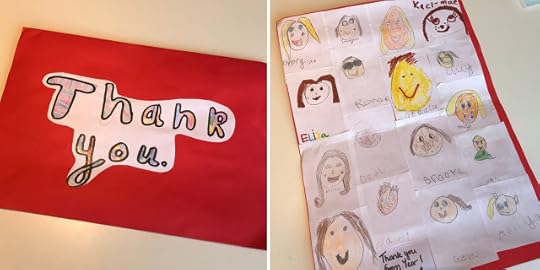
Garry Parsons is a children's book illustrator.
You can see more of my illustration for children's books on my website by clicking here. Get in touch to book Garry to visit your school, library or festival.
Follow me on twitter @icandrawdinos
One of the surprises of working as an illustrator in children’s publishing was being asked to take part in live events. My first picture book, Billy’s Bucketby Kes Gray, won three awards during the first year of its publication and, as the illustrator, I was expected to speak publicly. Being a fairly private person, this was very daunting at first and, looking back, I’m sure in those first few years my events were probably pretty awful. But experience is a great teacher and I have learnt a lot about speaking in public and adapted my repertoire to hopefully enthuse and inspire children to pick up a pencil or read a book.

This Friday I visited a school in South London, my first of the year, and, with the thought of a busy World Book Week close on the horizon, I was keen to start the season off with a real cracker.
Tip 1: Arrive in plenty of time.With my mild anxiety about being late dealt with by arriving at the school half an hour early, I was greeted enthusiastically by the teacher I had been organizing the event with, and led around the school to where my workshops would be taking place during the day, and to the hall for the assembly.

Tip 2: Set up your wares before the kids arrive.I like to be drawing as the children are filing into the hall. You can hear the muffled chatter of excitement and murmurs of “Who?” “What?” “How?” and “Wow!” Children are gripped by live drawing, so I like to make the most of the flip chart paper.

Tip 3: Get everyone’s attention straight away. I like to do this by asking a question immediately. “Does anyone here like to draw?” I ask, and usually around 80% of hands go up.

I go on to tell them that there are three things that an illustrator needs, we quickly work out between us what these might be, and I draw these on the flip chart with fast strokes of a fat marker. Children love to interact with moans and laughter when I inform them that my pencil is in love with someone but it’s not me!

We go through the importance of PRACTICE by unravelling a long concertina sketchbook, and the abstract notion of using your IMAGINATION by drawing a brave volunteer’s portrait. But I get it ‘wrong’ under the influence of my vivid imagination, which seemingly has a mind of its own and might add an elephant’s trunk, crazy oversized hair or giant ears to the drawing. This brings on peels of laughter.

By this point I usually feel I have the room engaged, but the time has flown by and I need to wrap it up with a five minute Q&A or, if it’s a longer assembly, I might continue with ‘Challenge the Illustrator,’ where I tell the children I can draw anything and they give me three random elements to put together in two minutes, a gorilla on a unicycle in Wembley Stadium or . Either way, my intention is to have lit a fuse of enthusiasm that will carry me and the students into a series of workshops for the rest of the day.

In the workshops I explain the process of illustration, from text to final artwork, and how a picture book is made. I use examples of my work to show each of the stages and emphasise how important it is to keep the first stages fluid and not to be concerned about perfection and getting things right. That's where the romance of the pencil and the rubber comes in.

So how did the day in South London go? Well, it was a marvellous day with responsive children and enthusiastic and welcoming staff, it felt great and everyone seemed happy.
This is what they said...
We had a very exciting visit from illustrator Garry Parsons. He amazed the children in an assembly with his illustration skills and quick imagination! His inspirational assembly and workshops had children in awe with a lot of spontaneous clapping.

But how do I know that schools really do get something out of author and illustrator visits? Is it worth schools spending scarce resources this way?
I asked two experienced teachers from schools in Kent to get an inside point of view on why author and illustrator visits might be of benefit to them and their pupils and how they know a visit may have had an effect.
Mrs Bryant told me:A visitor to your school can give pupils a fresh engagement with a subject, whether that is reading, writing or drawing, or even something less obvious like bee keeping or gymnastics. It can show children the aspect that gives education a purpose and gives them a reason for going to school. Authors and illustrators can be both inspirational and aspirational for pupils. Visits broaden views and often give a purposeful link to a unit of work that the pupils might be studying in class at that time or later, and we can ask questions such as “Would you like to do this as a job?”
Miss Neech told me:Meeting an author or illustrator in real life at your school brings in a reality, an actual person that children can directly engage with. And this is a shared experience for everyone in the school, including the teachers, and every school member can be uplifted by an inspiring speaker. When schools are required to focus on the academic, having a creative person, such as an illustrator or a writer, visiting the school is beneficial, because society is about creative thinking and problem solving. Not celebrating creativity would be a mistake!

For me, meeting the children is wonderful and I thoroughly enjoy visiting schools and having the opportunity to enthuse children about drawing and reading and about books.
This aspect of being an illustrator has become a pleasure I had never considered when I started on the art work for Billy’s Bucket all those years ago. While the benefits of authors and illustrators visiting schools might be hard to measure from my perspective, I am convinced that they have a real impact because of the feedback from teachers, the fun that I can see the children have and, more than anything, the brilliant thank you letters I sometimes receive a few weeks later.

Garry Parsons is a children's book illustrator.
You can see more of my illustration for children's books on my website by clicking here. Get in touch to book Garry to visit your school, library or festival.
Follow me on twitter @icandrawdinos
Published on January 13, 2019 23:38
January 6, 2019
Learning from Reflecting Realities and Reading the 1% by Chitra Soundar
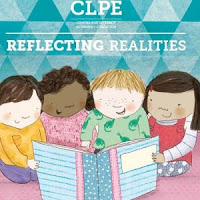 Based on the children's books published in 2017, CLPE researched and analysed the representation of ethnic minorities in children’s publishing. Their findings are available here.
Based on the children's books published in 2017, CLPE researched and analysed the representation of ethnic minorities in children’s publishing. Their findings are available here. Here in this blog post I wanted to highlight the findings for picture books.
According to their first ever analysis in 2018, only 6% of picture books published in 2017 featured a child from an ethnic minority. As an aunt of mixed-race nephews I was also deeply concerned to find that only 0.2% of all books published in 2017 featured mixed-race children in the narrative.
I looked at this report as a writer and wanted to explore how as writers we could contribute to the growth of this percentage. UK is a multi-cultural society, not now, but from Roman times. Check out this articleand furore over Mary Beard suggesting it was.
But whether they were fairy tales or the stories that Victorian Britain published even as an empire was hardly inclusive. But in 2018, if we are still discussing the lack of representation and not just by race, but also by ability, gender, sexual orientation, diverse types of families, then as a writer I think we do play a part in changing this.
Reading through the recommendations of the CLPE Reflecting Realities report (that sentence is weirdly alliterative), here are some of my key lessons for me as a writer, which not only applies to writing inclusively but also generally good writing.
a) Avoid the shorthand; Include the Specific: When portraying a child from a minority group, the details we use should be specific and authentic and should not degrade to a stereotypical two-dimensional shorthand. Isn’t that true of all stories and all children? The key to make something more universal is not making it two-dimensional, but highlighting the specific that is so authentic that the underlying truth shines through.b) Well-rounded representation of characters from ethnic backgrounds – research plays a huge part in this. Understanding a culture from the inside is no mean feat – there are subtle clues, vivid details and yet so many places where mistakes can be made. But isn’t that true for all character portrayals? Perhaps it feels easier when we write about things we know intimately. But when we write about something slightly distant from us, whether it is about another race or culture or even a person with a differing ability, should we go beyond the surface?c) Children love having fun. Isn’t that true? So why do children from a different race or ethnic group or even from families that are different from us just talk about their problems and issues? Should my nephews worry all the time about why their mum’s family eats different food to their dad’s side? Or should they just have fun, try different foods and do things their own way? While it’s great to showcase another culture or ethnic group, it’s important not just to portray the difference or their struggles lest the children should grow up thinking fun is for not for them. d) Children identify with characters in stories. Isn’t that why we have so many character led series that are such big hits? By extending that to children from a different race, why shouldn’t they see children they can identify with, as a series lead or as the main character of a picture book? Why do they have to be sidekicks always?e) First do no harm - And finally, while representing all races in important in stories, it’s also the responsibility of creators not to include characters just for the sake of it. A bad representation is worse than no representation. If a nuanced portrayal of a child from another culture or background than you is not possible either due to time or other constraints then as a writer I have to consider if I’m correct in including it anyway.
I’m from India and I often write stories set in India or Indian families. But even when I write about India, I do a lot of research to understand the region or family I’m writing about. Even though my stories would fit into the 1% that’s recorded in the survey, I still think there is a lot to think about when I choose topics to write or characters to portray. My goal is to write stories set in a mixed-race family and write about children just like my nephews, having fun, celebrating birthdays, making friends, going on vacation etc. And this report was helpful in identifying the areas I needed to focus.
CLPE are now re-launching their survey for books published in 2018. As an author or illustrator, if you think your book would qualify, read here and request your publisher to submit your book to the research.
Want to read inclusive books and don’t know where to buy them? Check out Letterbox Library.
 Chitra Soundar is an Indian-born British writer, storyteller and internationally published author of children’s books, based in London, England. Chitra writes picture books, poetry and fiction for children and often visits schools, festivals and libraries to tell her stories. Find out more at www.chitrasoundar.com. Follow her on Twitter @csoundar.
Chitra Soundar is an Indian-born British writer, storyteller and internationally published author of children’s books, based in London, England. Chitra writes picture books, poetry and fiction for children and often visits schools, festivals and libraries to tell her stories. Find out more at www.chitrasoundar.com. Follow her on Twitter @csoundar.
Published on January 06, 2019 23:00
December 31, 2018
Q and A with illustrator, Paula Bowles
Paula Bowles studied illlustration at Falmouth College of Arts. She now lives in Bristol, where she has worked as an illustrator for over 10 years. She is currently working on books with Nosy Crow and Simon & Schuster. 'Sammy Claws The Christmas Cat' (mine and Paula's first picture book together) was published by Nosy Crow this year. I am delighted that Paula has agreed to share some of her illustration wisdom with us and answer a few questions today. Paula, welcome to the Picture Book Den!
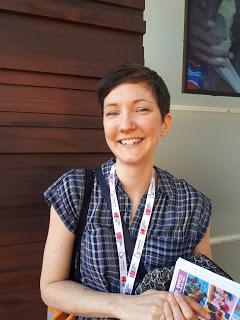
1) We love hearing about people’s paths into publishing. You’ve worked as an illustrator for over 10 years now. Can you tell us a bit about your journey?
I studied a 3 year Illustration degree at Falmouth College of Arts (now University College Falmouth). But, upon graduating in 2005, my portfolio was very different to what it is now! I phoned, wrote to and visited many different art directors and started getting work in editorial publications, but I never quite felt quite happy doing this, and really wanted to illustrate children’s books (lesson: be true to yourself!)
So, I went back to my drawing board and developed a portfolio of watercolour children’s book work, then I visited the Bologna book fair in 2007, and met Mark Mills (who worked at Meadowside publisher at the time). He then set up an agency called Plum Pudding Illustration and asked if I wanted to join; I said yes and am still represented by them 11 years later!
Mark, and now Hannah, have supported and helped me to develop my portfolio during that time, which has now changed considerably since working for many years in watercolour. My taste developed over time in to something different, until watercolour didn’t quite do what I wanted to express. So, once again, I developed a new portfolio. This time, whilst retaining a pencil and paper feel, I use digital media which allows me to play with bright punchy colours; this is how I work now and I’m the happiest I’ve ever been!
2) You’ve had experience of writing and illustrating your own books as well as illustrating texts by other authors. Which projects do you generally prefer to work on?
It’s hard to say which I prefer, I like doing both for different reasons! I really enjoy illustrating my own stories; I like the process of ‘discovering’ the story in a sketchbook, with words and pictures appearing together. But working on other authors stories is a dream too, because their writing is so different to mine, their stories are fresh and exciting. I feel I learn a lot from illustrating for other authors, and draw things I might not normally choose to draw! It’s also fun to have another person in the mix to celebrate and collaborate with when the book is published!
3) If you are collaborating on a book, what is it about a text that makes you want to illustrate it? Was there anything in particular about ‘Sammy Claws, The Christmas Cat’ that made you want to take it on?
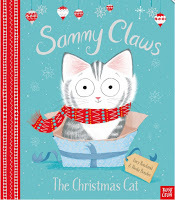 I love a good story! If it starts conjuring images in my mind as I read it, or it makes me chuckle or think or bring out different emotions, I know that’s a good thing and a good reason to illustrate it. When Nosy Crow sent me Lucy Rowland’s ‘Sammy Claws’ text, I just LOVED the story and the rhyme, and the story was fun and exciting, plus I love drawing cats! (And, it was my first book with Nosy Crow - and I just love their books! I was over the moon to be invited onboard the Crow’s nest!)
I love a good story! If it starts conjuring images in my mind as I read it, or it makes me chuckle or think or bring out different emotions, I know that’s a good thing and a good reason to illustrate it. When Nosy Crow sent me Lucy Rowland’s ‘Sammy Claws’ text, I just LOVED the story and the rhyme, and the story was fun and exciting, plus I love drawing cats! (And, it was my first book with Nosy Crow - and I just love their books! I was over the moon to be invited onboard the Crow’s nest!)
4) In the lead up to Christmas, you’ve been sharing all the different spreads from Sammy Claws. Which was your favourite spread to work on? Which is your favourite now? And were there any that you found particularly difficult?
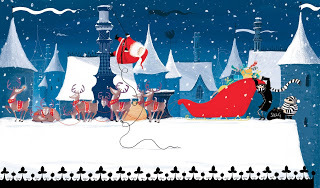
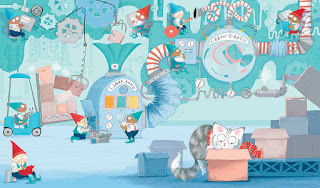 I think my favourite spread to work on was Spread 10, “Now, at a big castle (somewhere south of France)”. I like the composition flowing from left to right across the roof, all the snowy rooftops and turrets, as well as drawing all the different reindeer characters (I imagined Rudolph to be like a dog ‘pointing’, always alert and looking out for his boss, Santa, who I liked to imagine climbing the tall chimneys with climbing equipment!). I think that’s still my favourite spread, although it’s a close contender with Spread 4, the elves workshop, which was also probably the trickiest spread to do because of all the detail! Those elves took a long time to do, but they are good fun and I loved inventing the wrapping machine - the ‘i.WRAP.5000’!
I think my favourite spread to work on was Spread 10, “Now, at a big castle (somewhere south of France)”. I like the composition flowing from left to right across the roof, all the snowy rooftops and turrets, as well as drawing all the different reindeer characters (I imagined Rudolph to be like a dog ‘pointing’, always alert and looking out for his boss, Santa, who I liked to imagine climbing the tall chimneys with climbing equipment!). I think that’s still my favourite spread, although it’s a close contender with Spread 4, the elves workshop, which was also probably the trickiest spread to do because of all the detail! Those elves took a long time to do, but they are good fun and I loved inventing the wrapping machine - the ‘i.WRAP.5000’!
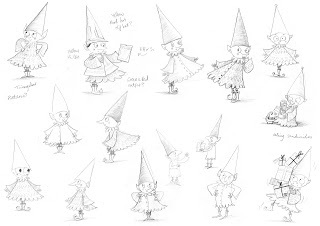
5) How you approach designing your characters? Do you read the text and automatically have an idea of what they look like or is there lots of trial and error?
I usually go through a process of sketching ideas for each characters, and they do change a fair bit during this process. Although, I felt certain that Sammy Claws should be a silver tabby from the moment I read the text, although there was a moment he could have been ginger! I love this stage of character development, sort of ‘getting to know’ the characters
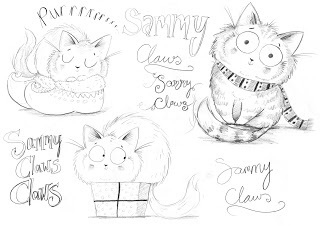
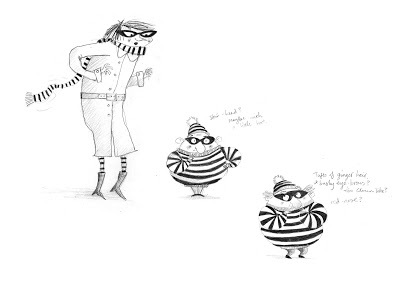
6) Could you tell us a bit about your typical working day as an illustrator?
I work from a shared studio which is a 30 min walk from my home. I usually arrive at the studio about 9.30am, make a cup of tea and settle down, answer emails, make a to-do list for the day, and catch up with my studio buddies. Then I put my headphones on and work until lunch, when I might pop out to the shops or, recently, I’ve joined ‘Borrowmydoggy.com’ so I might go and borrow a local dog for a lunch time walk! I usually stay at the studio until about 6 or 7, or later if there’s a deadline! Lately I’ve been working at least one day of the weekend too..because there’s just so much to get done… deadlines!! I definitely need to learn to take more breaks.
7) What is your top tip for budding illustrators who want to break into the publishing industry?
Keep drawing and developing your work! Keep visiting bookshops and seeing what’s new and learn about the area of publishing you are interested in. Share and show your work with friends, and to publishing people - no one will know you exist unless you show your work/contact publishers/agents/network. You will need patience, persistence and passion.
8) What is next on the horizon for you?
I have a picture book called Superkitty being published with Simon & Schuster in Febuary 2019, written by my agent Hannah Whitty! And I’m currently working on my second book with Lucy Rowland and Nosy Crow, as well as my second book with Simon & Schuster.
And just because it’s Christmas:
Mulled wine or Eggnog?Mulled Wine! (I have an aversion to eggs..)
Mince pie or Christmas pudding?Mince pies (served hot with a dollop of brandy butter)
Cracker jokes or Cracker hats?Cracker jokes.. love bad jokes!
Lazy Christmas morning lie-in or ‘up and opening presents at 6 am’?When I was a child I would be up at 5am! Now I’m a lazy so-and-so and enjoy a lie in.
Lots of little presents or one VERY BIG one? I prefer to give just one or two meaningful presents.
‘Christmas jumpers should be banned’ or ‘Is it even Christmas if you’re not wearing a Christmas jumper?’Haha! I love a good bit of knitwear! But am not really a fan of comedy Christmas jumpers… I love fair-isle pattern knitwear (as you can maybe tell from some of the patterns in Sammy Claws the Christmas Cat!I want Santa’s socks…and a blanket made out of the end-papers!)
You can find out more about Paula's work here:Agent: Twitter: @Paula_Bowles
Instagram: @PaulaBowles_Illustrator
or visit her website www.paulabowles.co.uk

1) We love hearing about people’s paths into publishing. You’ve worked as an illustrator for over 10 years now. Can you tell us a bit about your journey?
I studied a 3 year Illustration degree at Falmouth College of Arts (now University College Falmouth). But, upon graduating in 2005, my portfolio was very different to what it is now! I phoned, wrote to and visited many different art directors and started getting work in editorial publications, but I never quite felt quite happy doing this, and really wanted to illustrate children’s books (lesson: be true to yourself!)
So, I went back to my drawing board and developed a portfolio of watercolour children’s book work, then I visited the Bologna book fair in 2007, and met Mark Mills (who worked at Meadowside publisher at the time). He then set up an agency called Plum Pudding Illustration and asked if I wanted to join; I said yes and am still represented by them 11 years later!
Mark, and now Hannah, have supported and helped me to develop my portfolio during that time, which has now changed considerably since working for many years in watercolour. My taste developed over time in to something different, until watercolour didn’t quite do what I wanted to express. So, once again, I developed a new portfolio. This time, whilst retaining a pencil and paper feel, I use digital media which allows me to play with bright punchy colours; this is how I work now and I’m the happiest I’ve ever been!
2) You’ve had experience of writing and illustrating your own books as well as illustrating texts by other authors. Which projects do you generally prefer to work on?
It’s hard to say which I prefer, I like doing both for different reasons! I really enjoy illustrating my own stories; I like the process of ‘discovering’ the story in a sketchbook, with words and pictures appearing together. But working on other authors stories is a dream too, because their writing is so different to mine, their stories are fresh and exciting. I feel I learn a lot from illustrating for other authors, and draw things I might not normally choose to draw! It’s also fun to have another person in the mix to celebrate and collaborate with when the book is published!
3) If you are collaborating on a book, what is it about a text that makes you want to illustrate it? Was there anything in particular about ‘Sammy Claws, The Christmas Cat’ that made you want to take it on?
 I love a good story! If it starts conjuring images in my mind as I read it, or it makes me chuckle or think or bring out different emotions, I know that’s a good thing and a good reason to illustrate it. When Nosy Crow sent me Lucy Rowland’s ‘Sammy Claws’ text, I just LOVED the story and the rhyme, and the story was fun and exciting, plus I love drawing cats! (And, it was my first book with Nosy Crow - and I just love their books! I was over the moon to be invited onboard the Crow’s nest!)
I love a good story! If it starts conjuring images in my mind as I read it, or it makes me chuckle or think or bring out different emotions, I know that’s a good thing and a good reason to illustrate it. When Nosy Crow sent me Lucy Rowland’s ‘Sammy Claws’ text, I just LOVED the story and the rhyme, and the story was fun and exciting, plus I love drawing cats! (And, it was my first book with Nosy Crow - and I just love their books! I was over the moon to be invited onboard the Crow’s nest!)
4) In the lead up to Christmas, you’ve been sharing all the different spreads from Sammy Claws. Which was your favourite spread to work on? Which is your favourite now? And were there any that you found particularly difficult?

 I think my favourite spread to work on was Spread 10, “Now, at a big castle (somewhere south of France)”. I like the composition flowing from left to right across the roof, all the snowy rooftops and turrets, as well as drawing all the different reindeer characters (I imagined Rudolph to be like a dog ‘pointing’, always alert and looking out for his boss, Santa, who I liked to imagine climbing the tall chimneys with climbing equipment!). I think that’s still my favourite spread, although it’s a close contender with Spread 4, the elves workshop, which was also probably the trickiest spread to do because of all the detail! Those elves took a long time to do, but they are good fun and I loved inventing the wrapping machine - the ‘i.WRAP.5000’!
I think my favourite spread to work on was Spread 10, “Now, at a big castle (somewhere south of France)”. I like the composition flowing from left to right across the roof, all the snowy rooftops and turrets, as well as drawing all the different reindeer characters (I imagined Rudolph to be like a dog ‘pointing’, always alert and looking out for his boss, Santa, who I liked to imagine climbing the tall chimneys with climbing equipment!). I think that’s still my favourite spread, although it’s a close contender with Spread 4, the elves workshop, which was also probably the trickiest spread to do because of all the detail! Those elves took a long time to do, but they are good fun and I loved inventing the wrapping machine - the ‘i.WRAP.5000’!
5) How you approach designing your characters? Do you read the text and automatically have an idea of what they look like or is there lots of trial and error?
I usually go through a process of sketching ideas for each characters, and they do change a fair bit during this process. Although, I felt certain that Sammy Claws should be a silver tabby from the moment I read the text, although there was a moment he could have been ginger! I love this stage of character development, sort of ‘getting to know’ the characters


6) Could you tell us a bit about your typical working day as an illustrator?
I work from a shared studio which is a 30 min walk from my home. I usually arrive at the studio about 9.30am, make a cup of tea and settle down, answer emails, make a to-do list for the day, and catch up with my studio buddies. Then I put my headphones on and work until lunch, when I might pop out to the shops or, recently, I’ve joined ‘Borrowmydoggy.com’ so I might go and borrow a local dog for a lunch time walk! I usually stay at the studio until about 6 or 7, or later if there’s a deadline! Lately I’ve been working at least one day of the weekend too..because there’s just so much to get done… deadlines!! I definitely need to learn to take more breaks.
7) What is your top tip for budding illustrators who want to break into the publishing industry?
Keep drawing and developing your work! Keep visiting bookshops and seeing what’s new and learn about the area of publishing you are interested in. Share and show your work with friends, and to publishing people - no one will know you exist unless you show your work/contact publishers/agents/network. You will need patience, persistence and passion.
8) What is next on the horizon for you?
I have a picture book called Superkitty being published with Simon & Schuster in Febuary 2019, written by my agent Hannah Whitty! And I’m currently working on my second book with Lucy Rowland and Nosy Crow, as well as my second book with Simon & Schuster.
And just because it’s Christmas:
Mulled wine or Eggnog?Mulled Wine! (I have an aversion to eggs..)
Mince pie or Christmas pudding?Mince pies (served hot with a dollop of brandy butter)
Cracker jokes or Cracker hats?Cracker jokes.. love bad jokes!
Lazy Christmas morning lie-in or ‘up and opening presents at 6 am’?When I was a child I would be up at 5am! Now I’m a lazy so-and-so and enjoy a lie in.
Lots of little presents or one VERY BIG one? I prefer to give just one or two meaningful presents.
‘Christmas jumpers should be banned’ or ‘Is it even Christmas if you’re not wearing a Christmas jumper?’Haha! I love a good bit of knitwear! But am not really a fan of comedy Christmas jumpers… I love fair-isle pattern knitwear (as you can maybe tell from some of the patterns in Sammy Claws the Christmas Cat!I want Santa’s socks…and a blanket made out of the end-papers!)
You can find out more about Paula's work here:Agent: Twitter: @Paula_Bowles
Instagram: @PaulaBowles_Illustrator
or visit her website www.paulabowles.co.uk
Published on December 31, 2018 00:00
December 23, 2018
A feast of food! by the Picture Book Den
To celebrate the festivities, here's our choice of picture books that involve food, served with Seasons' Greetings from all of us at the Picture Book Den and wishing a very Happy New Year to all!
Jane Clarke

The Very Hungry Caterpillar can be used to talk about metamorphosis, and about greed, of course - but at this time of year - wouldn’t it be great to eat everything you want, and turn into something exquisitely beautiful?!

Lucy Rowland
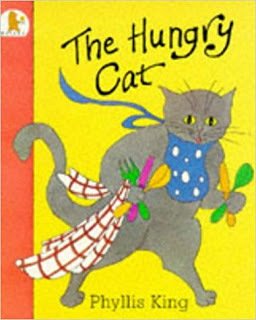
I loved this book when I was little! The hungry cat eats one fish. The hungry cat eats two potatoes. The hungry cat eats three tomatoes...all the way up to ...The hungry cat eats ten watermelons! At this point, rather unsurprisingly, the hungry cat feels sick! So....'Up come the ten watermelons! Up come the nine pizzas!.....all the way back down to 'Up comes the one fish!' and the hungry cat says....'Now I'm hungry again!' I'm not sure I ever learnt much about portion control from this book but I loved it all the same. There is even an embarrassing video of me reading it to my little sister somewhere.
Chitra Soundar
My choice of book to read this festive season, is from China. Although it's a bit early for Chinese New Year, it's a great story that's told in many cultures from Europe to Africa to Asia. It evokes memories of festivities, colour and feasts. Enjoy the holiday season! Written by Ying Chang Compestine, it's beautifully illustrated by Sebastia Serra.
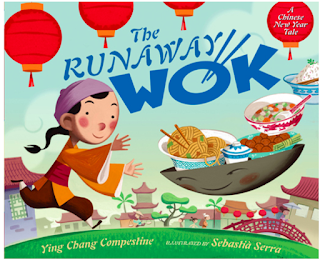
I nominate Shirley Hughes' 'Alfie's Christmas'. Because it shows the cosy chaotic sort of Christmas I am familiar with.
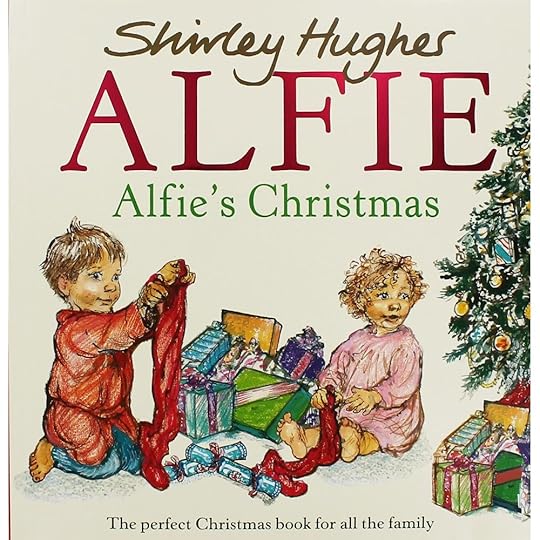
And it is the preparing of the food that is at least as much fun as the eating of it. Look at Dad and Alfie mixing what it tells them to in a recipe book, and then carefully cutting out Christmas tree shapes that we just know are going to be iced with silver baubles stuck on like Christmas tree lights. See Mum doing the messy job of stuffing the turkey whilst the cat looks on with longing!
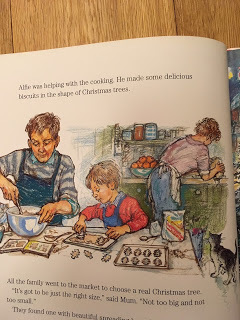
Natascha Biebow
This book makes me smile every time. I came across it accidentally at the library and was so enamoured by Sid, a clever cat who manages to scoff down six delicious dinners in one day! More that this, though, I love the sense of community in the story. In this second adventure, when the six families on his street all decide to go on holiday at the same time, who will feed Sid? A cattery would not accommodate six dinners! So, Sid goes on the train to the Scottish Highlands, where the families have rented six cabins. He soon feels right at home - and, after an exciting day exploring and meeting the local wildlife, Sid is happy he has six or maybe even seven dinners to come home to! Sid's first adventure, Six Dinner Sid was a Smarties Award winner and features in the Daily Telegraph's top 50 children's books of all time.
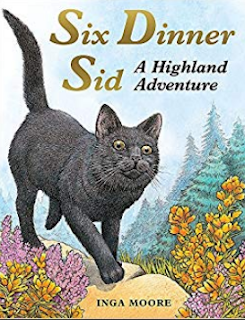
Garry Parsons
I've chosen "The Tea Party in the Woods" by Akiko Miyakoshi.

On a winter's day, Kikko rushes out of the house into the snow to chase after her father who has forgotten a pie he was meant to deliver to her grandmother. In her haste to follow him through the woods, Kikko stumbles and accidentally crushes Grandma's pie and then, by some strange circumstance, ends up being a guest in a house full of clothed animals.

The spread that really excites me is the tea party at the long table with Kikko sitting at the head of the table looking a little shocked by the company. I love the mysterious feel of this book and the raw quality of the drawing.
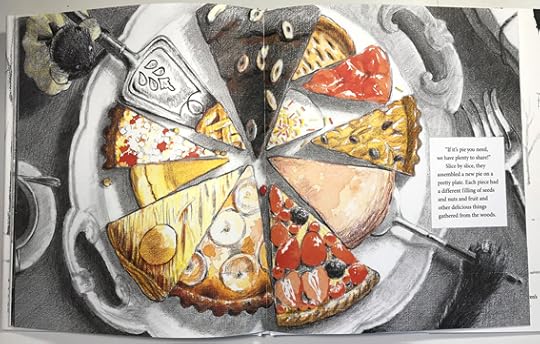
The animals then contribute slices from various flans and tarts at the table to replace the pie that got ruined and Kikko continues on her way to Grandma.
This is definitely a feast I'd like to be a guest at!
Jonathan Emmett
My favourite food-themed picture book is In the Night Kitchen by Maurice Sendak.
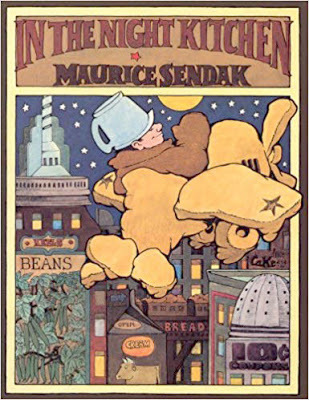
There are many picture books about dreams but, for me, this is the only one that come close to capturing the surreal, irrational, incongruous quality of a genuine dream – and it's beautifully illustrated to boot!
After being awoken by a mysterious noise in the night, Mickey falls through his bedroom floor into The Night Kitchen, a city-like landscape make up of giant packets, cartons and bottles.

There he meets three bakers (all of whom look like Oliver Hardy) who, with authentic dream-like logic, mistake Mickey for milk and proceed to mix him into the enormous cake they are baking.

Mickey eventually saves the day, the cake and himself by fashioning an aeroplane out of cake batter (I told you this was a surreal book) and flying off to fetch some actual milk.
Paeony Lewis
This time I simply can't resist including one of my old books, No More Biscuits! In the story, Florence eats all the biscuits, though she says Arnold ate some too (he's a toy monkey, but as we know, soft toys often get the blame for things).
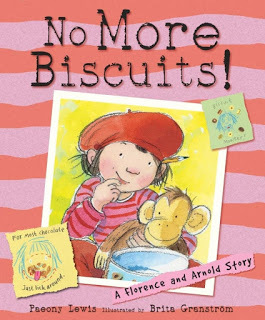 No More Biscuits! (No More Cookies! in the US)
No More Biscuits! (No More Cookies! in the US)
by Paeony Lewis, illustrations Brita GranstromFlorence tries to persuade Mum to give her just one more biscuit, but Mum is holding strong. It's a battle of wills, as used to happen in our house.
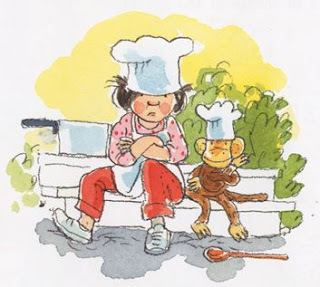
The story ends with a compromise and they all make delicious 'Magic Monkey Bananas'. If only world problems could be solved with frozen bananas covered in chocolate and sprinkles. Wishing everyone a peaceful and joyous 2019.
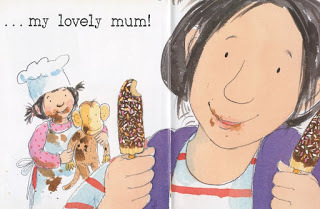
Jane Clarke

The Very Hungry Caterpillar can be used to talk about metamorphosis, and about greed, of course - but at this time of year - wouldn’t it be great to eat everything you want, and turn into something exquisitely beautiful?!

Lucy Rowland

I loved this book when I was little! The hungry cat eats one fish. The hungry cat eats two potatoes. The hungry cat eats three tomatoes...all the way up to ...The hungry cat eats ten watermelons! At this point, rather unsurprisingly, the hungry cat feels sick! So....'Up come the ten watermelons! Up come the nine pizzas!.....all the way back down to 'Up comes the one fish!' and the hungry cat says....'Now I'm hungry again!' I'm not sure I ever learnt much about portion control from this book but I loved it all the same. There is even an embarrassing video of me reading it to my little sister somewhere.
Chitra Soundar
My choice of book to read this festive season, is from China. Although it's a bit early for Chinese New Year, it's a great story that's told in many cultures from Europe to Africa to Asia. It evokes memories of festivities, colour and feasts. Enjoy the holiday season! Written by Ying Chang Compestine, it's beautifully illustrated by Sebastia Serra.

I nominate Shirley Hughes' 'Alfie's Christmas'. Because it shows the cosy chaotic sort of Christmas I am familiar with.

And it is the preparing of the food that is at least as much fun as the eating of it. Look at Dad and Alfie mixing what it tells them to in a recipe book, and then carefully cutting out Christmas tree shapes that we just know are going to be iced with silver baubles stuck on like Christmas tree lights. See Mum doing the messy job of stuffing the turkey whilst the cat looks on with longing!

Natascha Biebow
This book makes me smile every time. I came across it accidentally at the library and was so enamoured by Sid, a clever cat who manages to scoff down six delicious dinners in one day! More that this, though, I love the sense of community in the story. In this second adventure, when the six families on his street all decide to go on holiday at the same time, who will feed Sid? A cattery would not accommodate six dinners! So, Sid goes on the train to the Scottish Highlands, where the families have rented six cabins. He soon feels right at home - and, after an exciting day exploring and meeting the local wildlife, Sid is happy he has six or maybe even seven dinners to come home to! Sid's first adventure, Six Dinner Sid was a Smarties Award winner and features in the Daily Telegraph's top 50 children's books of all time.

Garry Parsons
I've chosen "The Tea Party in the Woods" by Akiko Miyakoshi.

On a winter's day, Kikko rushes out of the house into the snow to chase after her father who has forgotten a pie he was meant to deliver to her grandmother. In her haste to follow him through the woods, Kikko stumbles and accidentally crushes Grandma's pie and then, by some strange circumstance, ends up being a guest in a house full of clothed animals.

The spread that really excites me is the tea party at the long table with Kikko sitting at the head of the table looking a little shocked by the company. I love the mysterious feel of this book and the raw quality of the drawing.

The animals then contribute slices from various flans and tarts at the table to replace the pie that got ruined and Kikko continues on her way to Grandma.
This is definitely a feast I'd like to be a guest at!
Jonathan Emmett
My favourite food-themed picture book is In the Night Kitchen by Maurice Sendak.

There are many picture books about dreams but, for me, this is the only one that come close to capturing the surreal, irrational, incongruous quality of a genuine dream – and it's beautifully illustrated to boot!
After being awoken by a mysterious noise in the night, Mickey falls through his bedroom floor into The Night Kitchen, a city-like landscape make up of giant packets, cartons and bottles.

There he meets three bakers (all of whom look like Oliver Hardy) who, with authentic dream-like logic, mistake Mickey for milk and proceed to mix him into the enormous cake they are baking.

Mickey eventually saves the day, the cake and himself by fashioning an aeroplane out of cake batter (I told you this was a surreal book) and flying off to fetch some actual milk.
Paeony Lewis
This time I simply can't resist including one of my old books, No More Biscuits! In the story, Florence eats all the biscuits, though she says Arnold ate some too (he's a toy monkey, but as we know, soft toys often get the blame for things).
 No More Biscuits! (No More Cookies! in the US)
No More Biscuits! (No More Cookies! in the US)by Paeony Lewis, illustrations Brita GranstromFlorence tries to persuade Mum to give her just one more biscuit, but Mum is holding strong. It's a battle of wills, as used to happen in our house.

The story ends with a compromise and they all make delicious 'Magic Monkey Bananas'. If only world problems could be solved with frozen bananas covered in chocolate and sprinkles. Wishing everyone a peaceful and joyous 2019.

Published on December 23, 2018 23:00
December 16, 2018
Gift-Wrapped Characters Christmas Quiz
When I was a child, part of the excitement of the run-up to Christmas was shaking, squeezing and even sniffing the gift-wrapped presents beneath our Christmas tree in an attempt to deduce what was inside. For this year's Christmas quiz, I've gift-wrapped 10 picture book characters. Since shaking, squeezing and sniffing are not options, you'll have to work out who they are from their outlines alone. How many can you identify?
Click on each image to reveal the answer
1.

2.

3.

4.

5.

6.

7.

8.

9.

10.

How did you do?
10All present and correct: Your picture book character recognition skills are exemplary!7–9 Gifted : You know your Seuss from your Scheffler.4–6Some contents missing: Not bad, but perhaps you should add a few picture book classics to your Christmas list.1–3A bad wrap: You need to brush up on your picture book knowledge.
After five years writing for Picture Book Den, this is my last post as a Den member (although I may return for the occasional guest post). I've enjoyed being part of the team, but it's time for me to move on and focus on other commitments. Thanks to everyone at the Den for their support and friendship over the last few years and thanks to all the Den readers that have shared or commented on my posts.
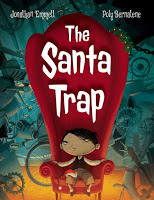 Jonathan Emmett's delightfully dark Christmas picture book
The Santa Trap
, illustrated by Poly Bernatene, is available in a UK paperback print-on-demand edition from Hatchling Books and a US Hardback edition from Peachtree Publishers.
Jonathan Emmett's delightfully dark Christmas picture book
The Santa Trap
, illustrated by Poly Bernatene, is available in a UK paperback print-on-demand edition from Hatchling Books and a US Hardback edition from Peachtree Publishers.
Find out more about Jonathan and his books at his Scribble Street web site or his blog. You can also follow Jonathan on Facebook and Twitter @scribblestreet.
See all of Jonathan's posts for Picture Book Den.
Click on each image to reveal the answer
1.

2.

3.

4.

5.

6.

7.

8.

9.

10.

How did you do?
10All present and correct: Your picture book character recognition skills are exemplary!7–9 Gifted : You know your Seuss from your Scheffler.4–6Some contents missing: Not bad, but perhaps you should add a few picture book classics to your Christmas list.1–3A bad wrap: You need to brush up on your picture book knowledge.
After five years writing for Picture Book Den, this is my last post as a Den member (although I may return for the occasional guest post). I've enjoyed being part of the team, but it's time for me to move on and focus on other commitments. Thanks to everyone at the Den for their support and friendship over the last few years and thanks to all the Den readers that have shared or commented on my posts.
 Jonathan Emmett's delightfully dark Christmas picture book
The Santa Trap
, illustrated by Poly Bernatene, is available in a UK paperback print-on-demand edition from Hatchling Books and a US Hardback edition from Peachtree Publishers.
Jonathan Emmett's delightfully dark Christmas picture book
The Santa Trap
, illustrated by Poly Bernatene, is available in a UK paperback print-on-demand edition from Hatchling Books and a US Hardback edition from Peachtree Publishers. Find out more about Jonathan and his books at his Scribble Street web site or his blog. You can also follow Jonathan on Facebook and Twitter @scribblestreet.
See all of Jonathan's posts for Picture Book Den.
Published on December 16, 2018 23:24
December 9, 2018
Christmas Mash-Up! by Pippa Goodhart
Bookshops are currently bright with selections of wonderful children’s Christmas books. Many of those books are picture books, and nearly all are books with pictures. There’s a brief but intense selling window for such books, and competition for sales is stiff.
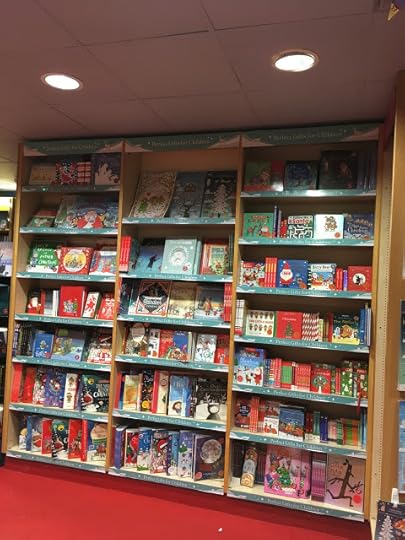
How best to compete amongst the glitter and beauty and fun of it all? The Nativity story is there in multiple forms, of course. So too are many stories about Santa and snowmen and elves and Christmas trees and nativity trees and presents. But there’s a new trend that I’ve noticed particularly because I’ve played a part in it. I’m calling it ‘the Christmas mash-up book.’ We all know some key trigger children’s book character and story types which have appeal – unicorns, diggers, monsters, fairies, dinosaurs, underpants, witches, fluffy bunnies and more – and now some of those characters have crossed what used to be an invisible boundary into Christmas.
So, for instance, here we have dinosaurs mixing with Christmas fun in Timonthy Knapman and Sarah Warburton's Dinosaurs Go Christmas Shopping

Fred Blunt pairs the Easter Bunny with Father Christmas, mixing originally religious festivals which have become more general to society. Easter Bunny is furious that Santa Claus has elves to do all the work of making the presents he gives whilst Bunny has to make the chocolate eggs himself. So Easter Bunny hatches a dastardly plan …. But of course it all ends in a funnily big-hearted way.
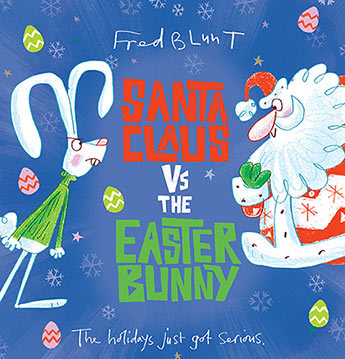
[image error]I was asked to write a Christmas chapter book story about Winnie the Witch and her cat Wilbur. Mixing witches with Santa? Here’s James Brown’s new book, Jingle Spells –
 There’s even been a Winnie the Witch picture book done before. In this one Winnie gets to fly with Santa –
There’s even been a Winnie the Witch picture book done before. In this one Winnie gets to fly with Santa – 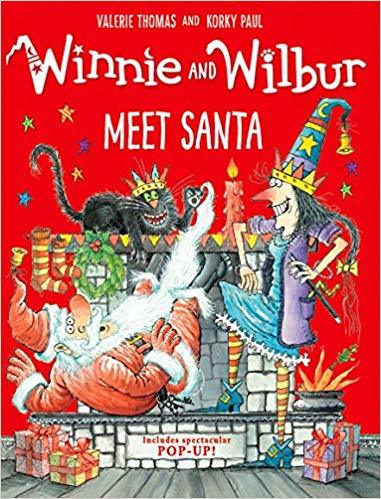 So I had to think of a story that didn’t have Winnie flying with Santa on his sleigh. In my story (written under the fake name of Laura Owen), Winnie suddenly realises that if Santa delivers presents to everybody, there will still be one person still left out; Santa himself. That’s not fair! So in this Santa Surprise story Winnie and Wilbur try to deliver a Christmas surprise to Santa, with inevitable daft disasters that culminate in success of a kind they hadn’t thought of. Korky Paul has turned it all into a wonderfully wild and whacky visual story, showing that ‘picture books’ can overlap with chapter books.
So I had to think of a story that didn’t have Winnie flying with Santa on his sleigh. In my story (written under the fake name of Laura Owen), Winnie suddenly realises that if Santa delivers presents to everybody, there will still be one person still left out; Santa himself. That’s not fair! So in this Santa Surprise story Winnie and Wilbur try to deliver a Christmas surprise to Santa, with inevitable daft disasters that culminate in success of a kind they hadn’t thought of. Korky Paul has turned it all into a wonderfully wild and whacky visual story, showing that ‘picture books’ can overlap with chapter books.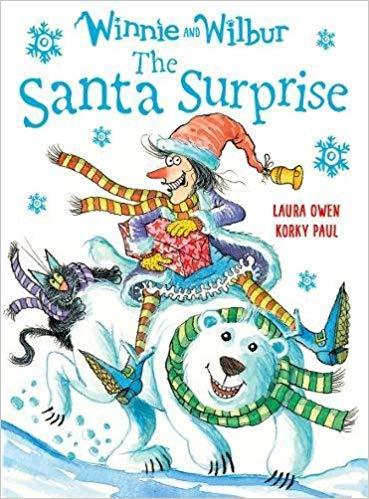 [image error]So, what would you like to see mashed-up with Christmas on the bookshelves next year?
[image error]So, what would you like to see mashed-up with Christmas on the bookshelves next year?And if anybody would like to give a child in need a wonderful book gift this year, do visit the Book Trust's website where you can donate - https://www.booktrust.org.uk/support-...
Happy Christmas!
Published on December 09, 2018 16:30
December 2, 2018
The Habit of Libraries Matters • Natascha Biebow
I have been thinking about libraries.
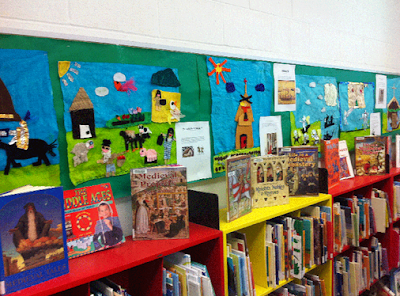
Libraries are of course buildings that house stacks of books, periodicals, newspapers, computers – they are places that house INFORMATION in all its modern guises. If you’re lucky, they also have kind and knowledgeable librarians, who will give you advice and order books for you. They might also be really, good listeners!
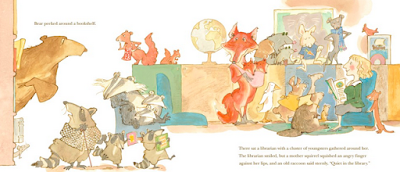 From A Library Book For Bear by Bonnie Becker - such a friendly librarian! My relationship with libraries was habit-forming from the outset. I can still remember the books I chose and read from our lower school library. In its reading corner, it had a huge, spectacular colourful papier-mâché elephant that gazed down kindly over our small selves. You could sit underneath it and chat or read. It was a friendly welcoming presence and a really good listener.
From A Library Book For Bear by Bonnie Becker - such a friendly librarian! My relationship with libraries was habit-forming from the outset. I can still remember the books I chose and read from our lower school library. In its reading corner, it had a huge, spectacular colourful papier-mâché elephant that gazed down kindly over our small selves. You could sit underneath it and chat or read. It was a friendly welcoming presence and a really good listener. 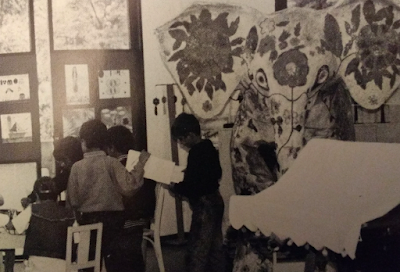 The Elephant in the EARJ libraryThis was the place you could go and browse the open stacks to find the next treasure to read, do research for your school work, and where you could meet your friends at break or lunchtime. It felt like home because it had books and I loved books like friends.
The Elephant in the EARJ libraryThis was the place you could go and browse the open stacks to find the next treasure to read, do research for your school work, and where you could meet your friends at break or lunchtime. It felt like home because it had books and I loved books like friends. In those pre-computer, pre-barcode days, remember how your library books each had a card that got stamped in and out with an inkpad? It seems incredibly old-fashioned now compared to the cool automated systems available now!
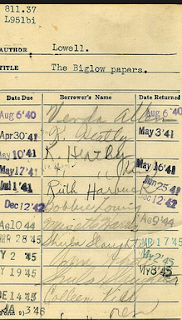
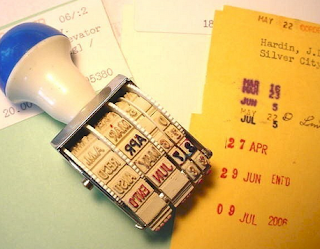
In high school, I often hung out at the library during lunch break and the librarian frequently had to tell me off for sneaking bites of my sandwich (“No eating in the library!") or laughing too loudly with my friends.
At university and in my early days working as a children’s book editor, the library was essential for inspiration, research and fact-checking. I was lucky enough to visit the British Library in its old reading room in the British Museum and pore over the stacks at the London Library.
 The magnificent old British Library Reading Room in BloomsburyNow, you can do a lot of this research from your desktop, but still, archives have to be housed somewhere, in a building, in a library. Recently for my book THE CRAYON MAN, I found it priceless to be able to research remotely using sources such as the online Library of Congress.
The magnificent old British Library Reading Room in BloomsburyNow, you can do a lot of this research from your desktop, but still, archives have to be housed somewhere, in a building, in a library. Recently for my book THE CRAYON MAN, I found it priceless to be able to research remotely using sources such as the online Library of Congress. When I became a parent, our local library became the weekly destination for the sing and rhyme session. I re-learned all those nursery rhymes I’d forgotten, key for developing early literacy, and a looked forward to the respite of seeing other parents and toddlers.
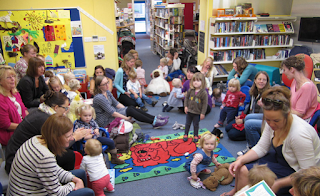 Rhyme time at the library Now my son is older, going to the library has become a habit we can share – a regular trip to explore its shelves yields a pile of books to explore. We have a golden ticket!
Rhyme time at the library Now my son is older, going to the library has become a habit we can share – a regular trip to explore its shelves yields a pile of books to explore. We have a golden ticket!
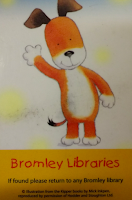
We have nothing to lose. It’s free (well, paid for by our council tax), and if the book is not the right fit, we can exchange it for another. In my life, libraries are first and foremost a place that has a truly priceless treasure – books I didn’t know I even needed to read!
Libraries are one of the oldest institutions of our society, but in many places in Britain, they are in trouble.

 Placards protesting against library closureAs funding is cut, many councils are either closing libraries or local volunteers are being drafted in to run them. In the case of the council where I live, the library is now run by a charitable social enterprise. The library is actually quite good still and we're incredibly lucky to have it within walking distance.
Placards protesting against library closureAs funding is cut, many councils are either closing libraries or local volunteers are being drafted in to run them. In the case of the council where I live, the library is now run by a charitable social enterprise. The library is actually quite good still and we're incredibly lucky to have it within walking distance. I went on a hunt to see if I could find some statistics about library usage among children. According to the data compiled by the DCMS Taking Part 2014/15 Annual Child Report in 2015, and reported by The Reading Agency:
• 68% of 5-10 year olds and 74% 11-15 year olds visited the library in the last year. • 14% of 5-10 year olds and 29% of 11-15 year olds visited the library in the last week • 35% of adults visited a public library in the last 12 months
It was also found that “libraries play a key role in providing books for children”.
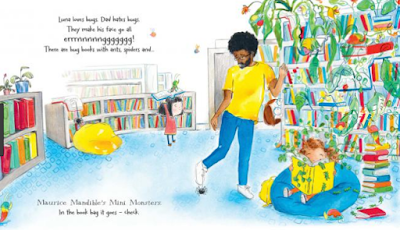 From Luna Loves Library Day by Joseph Coelho Interestingly, research by the Arts Council also showed evidence of “library users having higher life satisfaction, happiness and sense of purpose in life”. Library usage therefore goes beyond books and reading, but also impacts on mental health, social inclusion, community and increased well-being. Reading books holds the key to our future, to creating imaginative solution-driven children, developing all-important empathy, and creating a happier, more equitable, diverse and peaceful world. And libraries, after all contain books – and books are friends!
From Luna Loves Library Day by Joseph Coelho Interestingly, research by the Arts Council also showed evidence of “library users having higher life satisfaction, happiness and sense of purpose in life”. Library usage therefore goes beyond books and reading, but also impacts on mental health, social inclusion, community and increased well-being. Reading books holds the key to our future, to creating imaginative solution-driven children, developing all-important empathy, and creating a happier, more equitable, diverse and peaceful world. And libraries, after all contain books – and books are friends!
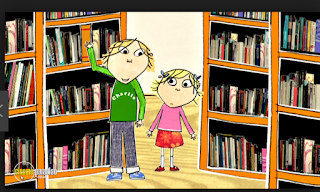 Charlie and Lola in the library by Lauren Child Want to know more? The Reading Agency Library Facts Impact report here You can read a very good argument for libraries and why reading matters by Chris Riddell and Neil Gaiman hereand in pictures
Charlie and Lola in the library by Lauren Child Want to know more? The Reading Agency Library Facts Impact report here You can read a very good argument for libraries and why reading matters by Chris Riddell and Neil Gaiman hereand in pictures How have libraries shaped you? ________________________________________Natascha Biebow, MBE, Author, Editor and Mentor
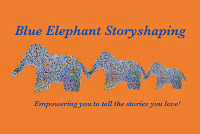 Natascha is the author of The Crayon Man (March 2019), Elephants Never Forget and Is This My Nose?, editor of numerous award-winning children’s books, and Co-Regional Advisor (Co-Chair) of SCBWI British Isles. She runs Blue Elephant Storyshaping, an editing, coaching and mentoring service aimed at empowering writers and illustrators to fine-tune their work pre-submission. Check out her Cook Up a Picture Book courses!
Natascha is the author of The Crayon Man (March 2019), Elephants Never Forget and Is This My Nose?, editor of numerous award-winning children’s books, and Co-Regional Advisor (Co-Chair) of SCBWI British Isles. She runs Blue Elephant Storyshaping, an editing, coaching and mentoring service aimed at empowering writers and illustrators to fine-tune their work pre-submission. Check out her Cook Up a Picture Book courses!
Published on December 02, 2018 21:00
November 25, 2018
A Good Q and A Session • Lynne Garner
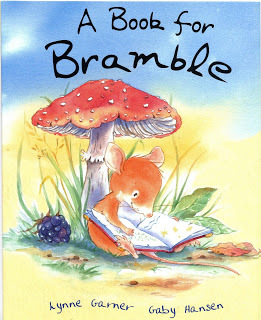 For a while I’ve been struggling with my picture book writing, simply no ideas. Then typically three evolved within the same week. The ideas germinated because I asked myself a few questions. This has happened to me before. Many years ago whilst checking on a hibernating hedgehog I was looking after I asked myself “what do hedgehogs dream about?” The answers I came up with finally became my very first picture book A Book For Bramble.
For a while I’ve been struggling with my picture book writing, simply no ideas. Then typically three evolved within the same week. The ideas germinated because I asked myself a few questions. This has happened to me before. Many years ago whilst checking on a hibernating hedgehog I was looking after I asked myself “what do hedgehogs dream about?” The answers I came up with finally became my very first picture book A Book For Bramble.This then made me wonder if other authors had had the same experience. Having asked myself this question I needed to know the answer. So, as I have direct access to the Picture Book Den team, I posed the question to them. It appears I’m not the only author to have had this experience and the following books are the results of questions these authors posed themselves.
In no particular order:
Neo Leon by Jane Clarke
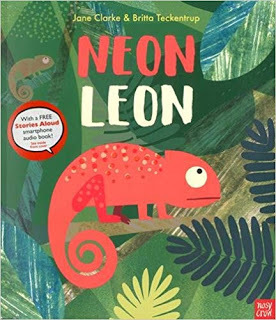
Jane wondered what would happen if a chameleon couldn’t change colour. She’s aware the real answer would be that it’s likely it would’ve been eaten whilst small. But, this book shows what a little imagination can achieve when you ask yourself one of those random questions.
You Choose by Pippa Goodhart
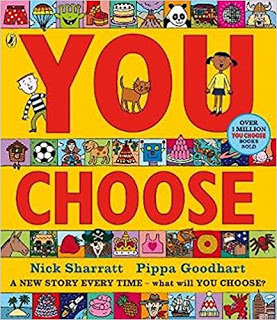
In Pippa’s own words “after seeing my children’s enjoyment of catalogues of toys, catalogues of clothing, kitchen and garden equipment aimed at adults, I asked myself, ‘would it be possible to make a catalogue of the much bigger choices we make in life?’ Her answer was “Yes! Simply use that catalogue treatment of showing a mass of choices, but take it into the realms of fantasy a little by offering children a mix of realistic and over the top homes, food, friends, jobs, and so on.” This format has worked so well that Pippa has also written Just Imagine and You Choose in Space.
Farmer Falgu Goes on a Trip by Chitra Soundar
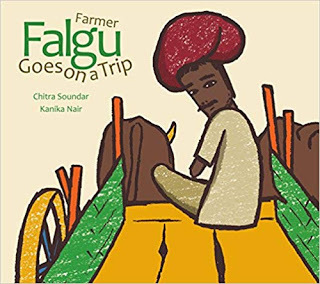
Chitra asked herself the simple question “is silence better than noise?” Her answer, which is explored in her book is “noise is joyous.”
The Crayon Man by Natasha Biebow
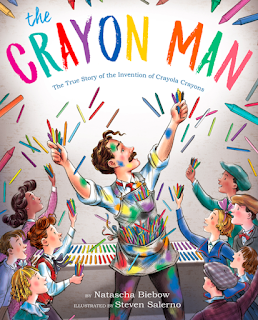
After watching Sesame Street with her son, which featured crayons Natasha found herself wondering who had invented them. So, she started digging for “story nuggets.” She used the archives at the Smithsonian Museum (Washington, DC), visited a Crayola factory and contacted the inventor’s family. All this research resulted in a non-fiction picture book that tells the story of Edwin Binney and his wonderful invention, the crayon.
So, it would appear I’m not the only author who has posed themselves a question and ended up with a book idea. So, the next time you’re suffering with writers block ask yourself a random question and see where the answers lead you.
Alternately if you’ve asked yourself a question and you need a few more imaginative answers then post them here. I’m sure between us we can help you create your next story.
Click here to visit my websiteClick here for my short story collections
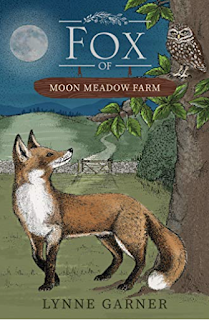 My latest short story collection
My latest short story collection
Published on November 25, 2018 23:00
November 18, 2018
Some not very serious life lessons from picture books by Jane Clarke
Last week, Book Trust tweeted

So, inspired by this thread, and with tongue firmly in cheek, here are some life lessons from a few of my favourite old picture books. I’ve confined myself to sausages, elephants and poultry - but feel free to add anything in the comments at the end :-)
1. If you strut about with your beak in the air, you’ll miss a lot of exciting stuff.
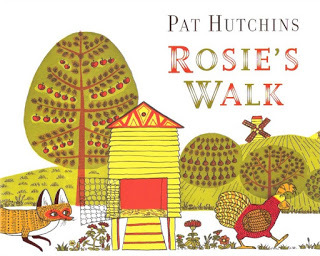
2. Never underestimate the power of compromise, especially when arbitrated by a duck.
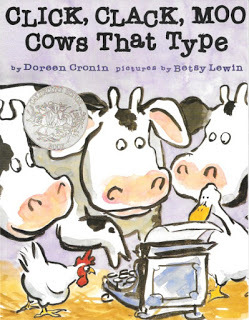
3. Fake wings may be cool, but they won’t enable you to fly.

4. Be nice to demanding house guests and treat yourself to sausages, chips and ice cream at a cafe after they leave.
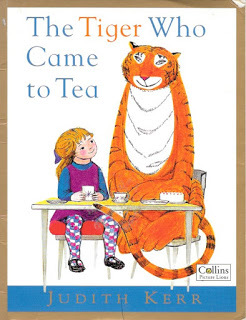
5. It's wise to keep sausages handy in case you need them to determine which end of an Earth Hound has the fangs, and which end has the waggler.
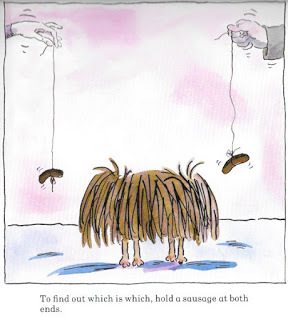 Dr Xargle's book of Earth Hounds by Jeanne Willis, illustrated by Tony Ross
Dr Xargle's book of Earth Hounds by Jeanne Willis, illustrated by Tony Ross
6. Elephants are happiest when they don’t try to hide their true colours.
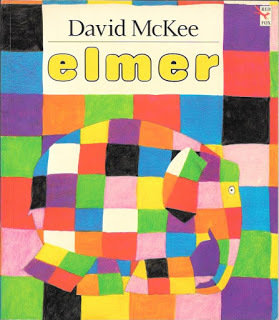
7. If there are four elephants in a bath, only three have fun.
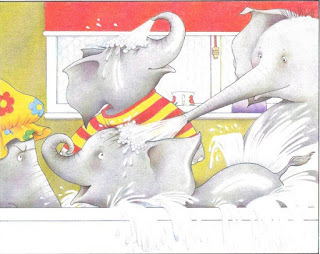 Five Minutes Peace by Jill Murphy
Five Minutes Peace by Jill Murphy
8. If you spend all day going rumpeta, rumpeta, rumpeta all down the road with an elephant, you will need to lie down at the end of it.
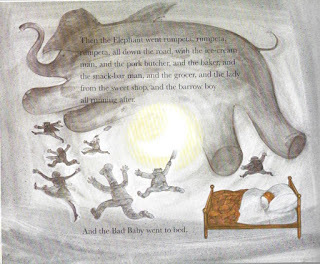 The Elephant and the Bad Baby by Elfrida Vipont and Raymond Briggs
The Elephant and the Bad Baby by Elfrida Vipont and Raymond Briggs
There are huge philosophical truths to be extrapolated from picture books and I recognise (somewhat guiltily) that the subject deserves a much more serious post than this. In the meantime, though, I hope you’ll leave a comment to let us know more life lessons (from the silly to the profound) you’ve learned from picture books.
Jane's just finished writing the Dr KittyCat series and is currently working on a third picture book to be illustrated by Britta Teckentrup, and the fourth book in the Al's Awesome Science series illustrated by James Brown.

So, inspired by this thread, and with tongue firmly in cheek, here are some life lessons from a few of my favourite old picture books. I’ve confined myself to sausages, elephants and poultry - but feel free to add anything in the comments at the end :-)
1. If you strut about with your beak in the air, you’ll miss a lot of exciting stuff.

2. Never underestimate the power of compromise, especially when arbitrated by a duck.

3. Fake wings may be cool, but they won’t enable you to fly.

4. Be nice to demanding house guests and treat yourself to sausages, chips and ice cream at a cafe after they leave.

5. It's wise to keep sausages handy in case you need them to determine which end of an Earth Hound has the fangs, and which end has the waggler.
 Dr Xargle's book of Earth Hounds by Jeanne Willis, illustrated by Tony Ross
Dr Xargle's book of Earth Hounds by Jeanne Willis, illustrated by Tony Ross6. Elephants are happiest when they don’t try to hide their true colours.

7. If there are four elephants in a bath, only three have fun.
 Five Minutes Peace by Jill Murphy
Five Minutes Peace by Jill Murphy8. If you spend all day going rumpeta, rumpeta, rumpeta all down the road with an elephant, you will need to lie down at the end of it.
 The Elephant and the Bad Baby by Elfrida Vipont and Raymond Briggs
The Elephant and the Bad Baby by Elfrida Vipont and Raymond BriggsThere are huge philosophical truths to be extrapolated from picture books and I recognise (somewhat guiltily) that the subject deserves a much more serious post than this. In the meantime, though, I hope you’ll leave a comment to let us know more life lessons (from the silly to the profound) you’ve learned from picture books.
Jane's just finished writing the Dr KittyCat series and is currently working on a third picture book to be illustrated by Britta Teckentrup, and the fourth book in the Al's Awesome Science series illustrated by James Brown.
Published on November 18, 2018 22:30



